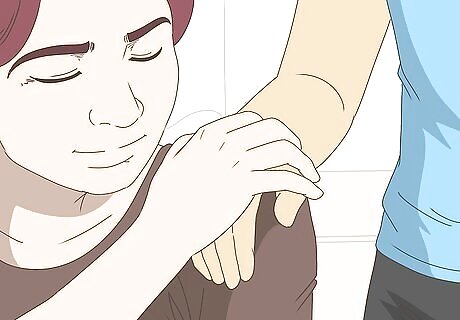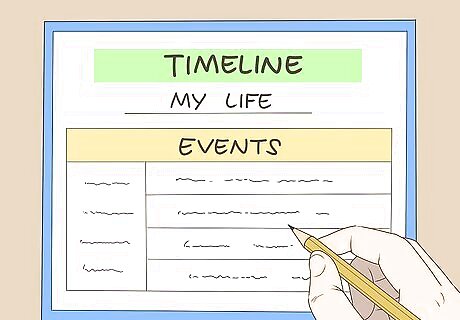
views
X
Research source
They provide sources of support when we need guidance, as well as inspiration through collaboration. Best of all, they satisfy the basic human need to fit in and belong to a group that we respect and admire. Building healthy interpersonal relationships takes time, practice, and attentiveness to ones' self and the needs of others.
Building Relationships

Meet new people. Humans are social creatures by nature, even introverts. For this reason, you may need to take opportunities to interact with others if you want to build healthy relationships with others. Find reasons to put yourself in contact with other people. The more times you do this, the more likely that you will interact with others, and the more likely those interactions will be meaningful. Go out. Go to a coffee shop, Take a trip. Attend a concert or play. Find meet-ups. Find groups in your community that share your values and interests and go to events they host. Meetup.com is a great resource for this, but there are others you can find through a brief online search. Be available. Make yourself say "yes" to invitations from acquaintances, coworkers, family, and friends. This can be as simple as lunch on a Friday, to camping on the weekend, to attending a child's dance recital. It doesn't matter what you've been invited to. Provided it doesn't interfere with necessary weekly responsibilities, just say "yes."

Respect diversity. When we respect diversity, we respect the right of others to be different from ourselves, opening the door to safer, more meaningful and fruitful interactions. Ways to respect diversity are: Learn about another culture or religion by attention a service at a worship center. Volunteer in your community to help individuals with disabilities or special needs. Travel to other countries and practice local customs when possible and respectful to do so. Watch documentaries that introduce you to different cultures and parts of the world.

Focus on relationship quality. High-quality personal relationships are defined by closeness, respect, shared values and support. Studies have shown that quality personal relationships not only help our mental health but also contribute to our physical well-being. Spend quality time together engaging in meaningful activities. For example, go on a walk, visit a museum, or just sit and have a conversation.

Build trust. Trust is an essential component of a healthy relationship — it is difficult to make a deeper connection if you don't feel safe with the other person. Demonstrate your trustworthiness by admitting when you are wrong and apologizing sincerely, being reliable, and communicating openly. You should look for people with these same attributes. If you can't be accountable for your actions and try to blame your mistakes on others, it will be hard for people to trust you. Admit your mistakes and apologize sincerely. Be reliable by following through with your promises. This can be as simple as showing up to hang out with your friend when you said you would or completing a work project by the agreed-upon deadline. Show other people that when you say you'll do something, they can trust that you will do it. Say what you mean and do what you say. Don't tell someone you will keep a secret and then share it with someone else. Your behaviors and words should match up. Remember that this is a gradual process — you need to earn a person's trust, especially if they have been burned in the past.

Treat others with kindness. This isn't simply doing sweet things for others, like giving gifts, but how you interact with others day to day. Treating others with genuine kindness and respect is an integral part of building a healthy connection. Trusting someone and deepening your relationship requires vulnerability, and it will be difficult for anyone to be vulnerable with you if they think you may mock them or treat them badly. Kindness, on the other hand, makes people feel valued and cared for. One instance in which can be difficult to show kindness is during conflict. Instead of blaming, yelling, calling the person names or exploiting their insecurities, choose instead to express why you are hurt and angry.
Communicating Healthfully

Engage in verbal communication. The easiest way to meet people, even briefly, is to start a conversation. Research shows that communication, even when required, actually makes us happier and have a more positive outlook on people generally. Be assertive. Assertiveness is about talking about your thoughts and feelings in appropriate and respectful ways. Be honest. Be transparent with people about who you are. People can sense honesty, and it encourages them to trust you in return. Additionally, beginning a relationship with lies means those lies have to be maintained thence forth, and increases the risk of the lie being exposed, compromising the relationship. Ask open-ended questions. Get people to talk about themselves. Not only does this enable sharing, trust and intimacy, but it helps you guide the conversation toward topics that are comfortable for you.

Listen. Listening is the first step to building a strong rapport with others. It shows that we value who they are as well as what is being said. Some keys to good listening are: Maintain eye contact: This doesn't mean staring, but it does mean focusing your attention on the companion as opposed to your phone or a person across the room. Maintain appropriate body language: Your body language can help reinforce confidence in your companion. Don't fidget or check your watch. Nod when the other person makes a relevant point. Don't interrupt: Let the other person finish before asking “May I ask/add something?” You can, however, show that you are listening by nodding and making affirming noises, like "Uh-huh," or saying something like, "I see." Keep an open-mind: Don't let fear or bias guide your communication. Demonstrate that you respect the other person, in spite of points on which you do not agree.

Display non-verbal communication. Think carefully about what your non-verbal cues say to others. Non-verbal communication reinforces and accents what we are thinking and feeling. In order to appear confident in non-verbal communication, try to speak at a normal rate (not too fast or too slow), make frequent eye-contact (but don't stare, look away sometimes), avoid shaking your legs or fidgeting, and try to keep an open presentation (e.g. no arm crossing).

Resolve conflicts in healthy ways. Conflict, even between like-minded people, is inevitable, and when we are frustrated, it can be easy to say things and act in ways that reflect that frustration and not our values. In order to resolve conflict constructively: Avoid aggressive body language (such as pointing in someone's face, standing too close, rolling your eyes, etc.) or language. Ask questions and present views fairly. Refuse to name call or resort to character attacks. Always remind the other person that you respect his views and the right to have them.
Increasing Intimacy

Empathize. Empathy with another person conveys warmth, validation, and caring. It is the foundation of healthy relationships, building upon listening and respect. Empathy requires that we contribute our own similar experiences through conversation and reinforce values that we share with the other person. When someone views you as empathetic, they are more likely to confide, trust, and hold you in esteem, the foundational pillars of a good relationship. Practice empathy, not sympathy: Sympathy is a feeling a sadness inspired when we hear someone else's pain and focus on our own similar tragedies. Empathy keeps the focus on the other person, attempting to listen to and feel her pain, unique from your own.

Show compassion. Compassion requires self-analysis to examine the causes of our own pain and inspires unwillingness to inflict that same pain on others. It means supporting the right of others to thrive and be happy, even if we do not always agree with their views. At its base level, compassion is an act of kindness that reassures others that we find them worthy and valuable. Try to enact compassion in your own life by: Offer compassion to those who have mistreated you: Perhaps the hardest act of compassion is to someone we are tempted to believe does not deserve it. The best thing to do is to put yourself in the other person's positions and imagine what events they have gone through that have produced the anger and pain they inflict on others. Allow yourself to feel empathy for that pain, and channel it into kindness and tolerance for that person. Focus on common ground: People are more alike than different. We all thrive on similar things — love, trust, support, belonging. Just because these desires may manifest outwardly in unique ways does not mean that we are unalike. When you find yourself dwelling on difference, try to shift your focus back to similarities by reminding yourself that, like you, this person is seeking happiness, known suffering, seeks safety, and is still learning about the world.

Give back. Reciprocity is an important component of developing strong connections with others.Think of ways that you can lift a burden from the shoulders of another, if only for a moment. Showing you are there for someone and really care for them can help deepen your relationship. Offer acts of kindness. For example, you babysit for free when a neighbor needs a night off from the kids, help a friend move, tutor your little sister in math. Do these things with no expectation of payment or reciprocity — do it simply as a kindness. Do something nice for others. You could give a gift or words of encouragement. Show support by lending a helping hand or offering to assist in some way. Share responsibilities in roommate or shared housing situations (such as cleaning and paying bills, etc).
Knowing Yourself

Understand how self-exploration helps your relationships with others. While you may want to focus on learning how to have healthy relationships with other people, learning about yourself can actually help you achieve this goal. It is important that you take the time to get to know who you are and what makes you tick, your likes and dislikes, and simply how you experience the world so that you can relate to others in a healthy way. For instance, being aware of things that set you off can keep you from overreacting. Perhaps you felt that your father didn't listen to you when you tried to talk to him, and now you know that you tend to lose your cool when you someone doesn't answer your question right away. If you are aware of this tendency, you can stop yourself before you snap at the person, reminding yourself, "I'm getting upset because this reminds me of Dad. Susan may be formulating a response, or she simply may not have heard me. There is no need to overreact." Then you avoid blowing up at Susan and possibly damaging your relationship with her.

Keep a journal. Journaling is a way to let our inner self emerge. It allows us to facilitate dialogue between our ideal self-image and our present self. It can also act as a quiet, centering activity where we confess to page those things we are not ready to speak about. Below are some prompts that can help trigger introspection: Who am I? What do I love? What would you tell your older self?

Compose a timeline. The purpose of writing a timeline is to take stock of your goals and your progress toward them. This can be helpful, both as a tool of validation for how far you've come, and a motivator to keep you striving toward the next milestone. Some things to remember as you are constructing your timeline: Decide where it will begin and end. It doesn't have to start with birth. Make a preliminary list of events that need to be included. This should be based on what you perceive as meaningful and valuable. Include a title. Come up with something more detailed than, “My life.” The title should both guide how the timeline is read and reflect the values inherent in it's creation.

Self-Actualize. The term “self-actualization” originates with humanistic psychologist Abraham Maslow. It describes the process by which we fulfill lower-level needs so that we are then able to fulfill more conceptual needs.. This ideology places strong emphasis on all levels of self-care and embracing ones needs. Those needs are: Physiological security: food, shelter, warmth, air Safety: Protection from harm or threat Belonging: Inclusion in a group, love, the freedom to take what is needed and give unselfishly. Self-Esteem: Positive self-image “Being”: the ability to explore abstract creative impulses and fulfill personal meaning.




















Comments
0 comment